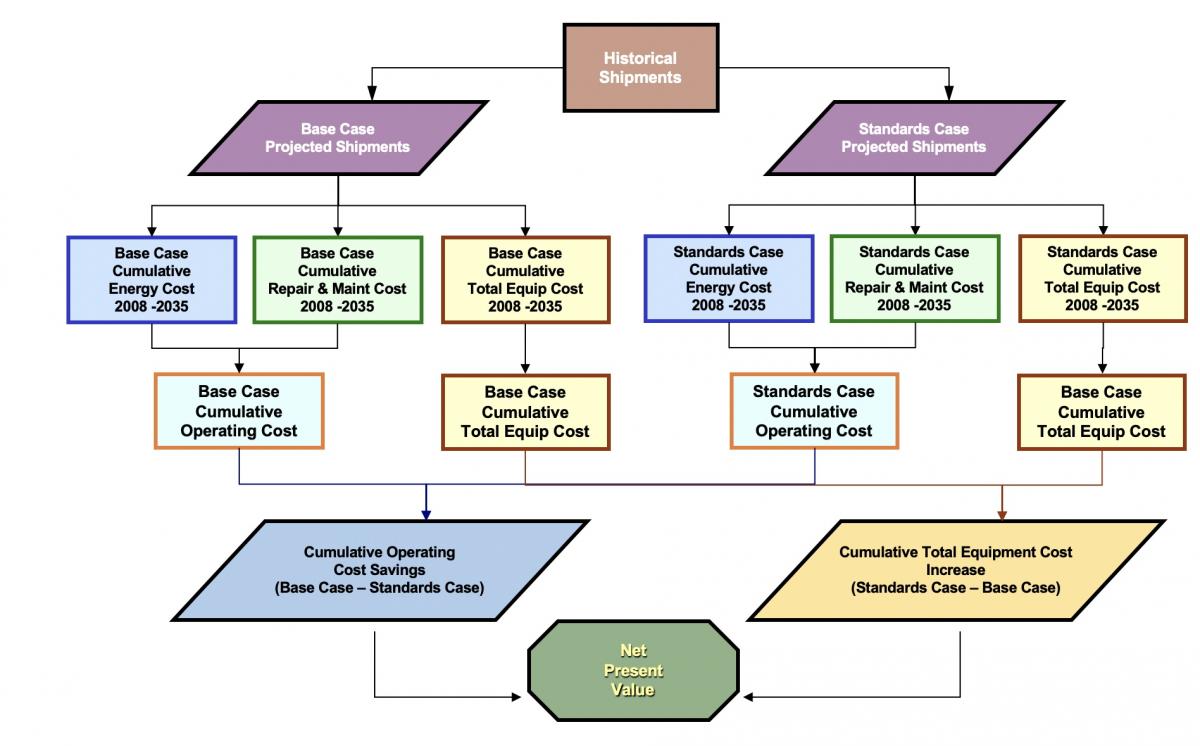The national impacts assessment quantifies the energy savings and economic impacts estimated to accrue over the lifetime of the products considered in the analysis. The Department of Energy typically considers impacts for 30 years of shipments for the specific product in question. Thus, the analysis needs to consider the entry of products into the stock over time and their impacts until they are retired. A key part of our analysis is consideration of efficiency changes that may take place in the absence of new or revised standards.
National Energy Savings Analysis
We calculate annual national energy savings (NES) as the difference between national energy consumption in a no-new-standards case and under each efficiency level considered. The inputs for determining the NES are: (1) lifetime energy consumption per unit, (2) shipments, (3) product stock, and (4) site-to-power-plant and full-fuel-cycle conversion factors for energy. We calculate national energy consumption by multiplying the number of units, or stock (by vintage, or age), by the unit energy consumption (also by vintage). We estimate energy consumption and savings based on site energy consumption, which it then converted to primary and FFC energy using annual conversion factors.
Full-Fuel-Cycle Accounting
The term full-fuel-cycle (FFC) refers to the complete fuel production chain including extraction, processing, conveyance to the retail distribution center, and delivery to final consumers. We have developed a definition of a full-fuel-cycle metric that is flexible enough to describe a wide variety of energy production chains and has sufficient mathematical rigor to allow meaningful comparisons between them. For ease of use in applications, the metric is defined as an FFC multiplier which, when applied to the point-of-use energy consumption, gives an estimate of the FFC energy use.
National Net Economic Benefit Analysis
The national net economic benefits associated with adopting standards at various considered efficiency levels are expressed as the net present value (NPV) of the total costs and benefits experienced by purchasers of the considered appliances.
The main inputs for determining the NPV are:
- total annual installed cost
- total annual savings in operating costs;
- a discount factor to derive the present value of costs and the present value of savings.
We calculate net savings each year as the difference between the base case with no new or revised standards and each standards case in terms of the total savings in operating costs and total increases in installed costs.
We calculate savings over the life of each product. The NPV is the difference between the present value of operating cost savings and the present value of total installed costs.

Analysis Example and Tool
A recent example of a national impacts analysis is described in chapter 10 in the Final Rule Technical Support Document for Commercial and Industrial Pumps. The associated spreadsheet may be found in the docket for Energy Conservation Standards for Commercial and Industrial Pumps.
Related Publications
Kantner, Colleen, Mohan Ganeshalingam, Robert Hosbach, and Liat Zavodivker."Impact of the EISA 2007 backstop requirement on general service lamps." (2021) PDF
